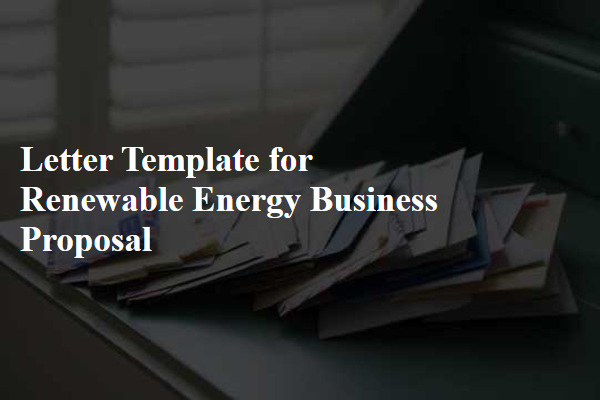Are you ready to tap into the power of renewable energy? With all the advancements in sustainable technologies, there's no better time to explore innovative solutions that can benefit both your business and the environment. In this article, we'll guide you through a comprehensive letter template designed specifically for proposing renewable energy initiatives. So, let's dive in and discover how you can make a positive impact on the planet while enhancing your business's bottom lineâread on!

Clear project goals and objectives
A renewable energy business proposal must outline clear project goals and objectives to ensure alignment with stakeholders and funding entities. Establishing goals such as achieving a minimum of 30% reduction in carbon emissions within the first three years, and transitioning to 100% renewable energy sources by 2030 are pivotal for sustainability. Specific objectives may include securing financing options like green bonds or local government grants, implementing community engagement programs to raise awareness about benefits of solar and wind energy, and constructing a pilot solar farm in a selected area with an annual capacity of 500 megawatts. These measurable outcomes not only promote environmental stewardship but also enhance economic growth within local communities, aligning the project with global efforts towards achieving the United Nations Sustainable Development Goals (SDGs).
Identification of target audience and stakeholders
Identifying the target audience and stakeholders is crucial for the success of a renewable energy business proposal. Potential audience members include residential homeowners seeking sustainable energy solutions, businesses aiming to reduce operating costs, and government entities interested in compliance with environmental regulations. Key stakeholders may involve local community leaders, renewable energy advocates, investors focused on sustainable projects, and utility companies transitioning to greener energy sources. Engaging with these groups effectively can enhance collaboration, foster support, and facilitate the implementation of renewable energy initiatives, such as solar panel installations or wind farm developments in specific regions like California or Texas, known for their favorable climatic conditions and policy frameworks.
Outline of benefits and ROI
Investing in renewable energy projects, such as solar photovoltaic (PV) systems or wind turbine farms, presents significant financial and environmental benefits. Businesses can achieve a return on investment (ROI) of approximately 15-25% over a 20-year period, depending on initial capital costs, government incentives, and energy savings. In the United States, the federal Investment Tax Credit (ITC) offers a 26% tax incentive for solar installations, which bolsters financial viability. Renewable energy sources can reduce utility bills by up to 70% in regions with high electricity rates, fostering greater cash flow. Additionally, decreased reliance on fossil fuels mitigates the risks associated with price volatility and regulatory changes. Implementing green energy solutions enhances corporate sustainability, boosts brand loyalty, and attracts environmentally-conscious consumers, positioning businesses favorably within the market. This shift toward renewable energy also contributes to a substantial reduction in carbon emissions, aligning with global climate goals, such as the Paris Agreement targets established in 2015.
Regulatory compliance and sustainability impact
Regulatory compliance in the renewable energy sector ensures adherence to local, national, and international laws aimed at promoting sustainable practices in energy production. The Clean Air Act (CAA) and the Renewable Portfolio Standard (RPS) in the United States provide frameworks that regulate emissions and mandate a certain percentage of energy derived from renewable sources, such as solar and wind. Furthermore, Compliance with the International Renewable Energy Agency (IRENA) guidelines fosters global collaboration and innovation, enhancing sustainability initiatives worldwide. Assessing sustainability impact involves evaluating effects on ecosystems, biodiversity, and communities, often utilizing tools like Life Cycle Assessment (LCA) to gauge carbon footprints and resource consumption. For instance, transitioning to 100% renewable energy sources can significantly reduce greenhouse gas emissions, mitigate climate change, and promote energy independence. Engaging stakeholders, including local governments and environmental organizations, is crucial in driving collective efforts towards a greener future.
Detailed financial and technical plan
A comprehensive renewable energy business proposal requires a detailed financial and technical plan. The financial plan includes projected costs, potential revenue streams, investment needs, and return on investment (ROI) calculations which typically span over five to ten years. Elements like capital expenditures (CapEx) for solar panel installations, wind turbine expenses, or geothermal systems provide clarity on initial investments. Operational expenditures (OpEx) associated with maintenance, labor, and utilities are also vital for budget assessments. The technical plan outlines the specific renewable energy technologies to be implemented, such as photovoltaic solar systems for harnessing sunlight or offshore wind farms capable of generating substantial energy. Incorporating a project timeline for implementation milestones along with regulatory compliance measures ensures adherence to state and federal laws. Additionally, potential partnerships with local governments or environmental organizations may enhance credibility and community support for the initiative. Comprehensive market analysis indicating projected energy savings, client acquisition strategies, and competitive positioning strengthens the proposal's attractiveness and feasibility.
Letter Template For Renewable Energy Business Proposal Samples
Letter template of energy efficiency program proposal for government grants

Letter template of clean energy advocacy proposal for local organizations

Letter template of sustainable energy solution proposal for corporate clients











Comments